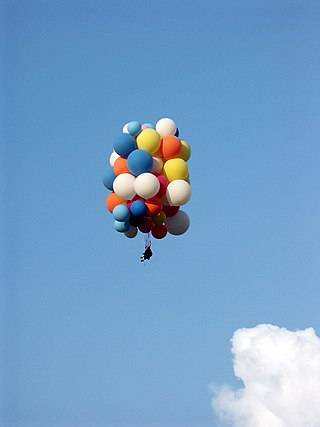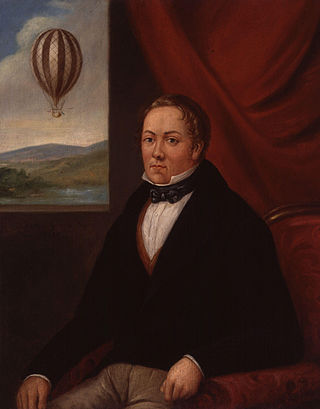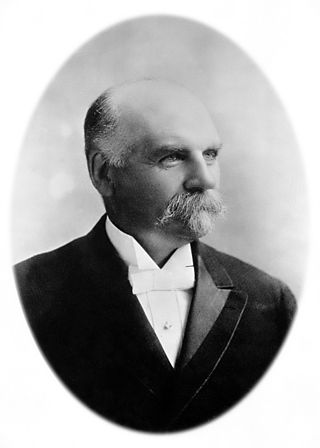Related Research Articles

Auguste Antoine Piccard was a Swiss physicist, inventor and explorer known for his record-breaking hydrogen balloon flights, with which he studied the Earth's upper atmosphere. Piccard was also known for his invention of the first bathyscaphe, FNRS-2, with which he made a number of unmanned dives in 1948 to explore the ocean's depths.

Jean Felix Piccard, also known as Jean Piccard, was a Swiss-born American chemist, engineer, professor and high-altitude balloonist. He invented clustered high-altitude balloons, and with his wife Jeannette, the plastic balloon. Piccard's inventions and co-inventions are used in balloon flight, aircraft and spacecraft.

On July 2, 1982, Larry Walters made a 45-minute flight in a homemade aerostat made of an ordinary patio chair and 45 helium-filled weather balloons. The aircraft rose to an altitude of about 16,000 feet (4,900 m), drifted from the point of liftoff in San Pedro, California, and entered controlled airspace near Long Beach Airport. During the landing, the aircraft became entangled in power lines, but Walters was able to climb down safely. The flight attracted worldwide media attention and inspired a movie and numerous imitators.
This is a list of aviation-related events from 1902:

In aeronautics, a balloon is an unpowered aerostat, which remains aloft or floats due to its buoyancy. A balloon may be free, moving with the wind, or tethered to a fixed point. It is distinct from an airship, which is a powered aerostat that can propel itself through the air in a controlled manner.

Jacques Piccard was a Swiss oceanographer and engineer, known for having developed underwater submarines for studying ocean currents. In the Challenger Deep, he and Lieutenant Don Walsh of the United States Navy were the first people to explore the deepest known part of the world's ocean, and the deepest known location on the surface of Earth's crust, the Mariana Trench, located in the western North Pacific Ocean.

Charles Green was the United Kingdom's most famous balloonist of the 19th century. He experimented with coal gas as a cheaper and more readily available alternative to hydrogen for lifting power. His first ascent was in a coal gas balloon on 19 July 1821. He became a professional balloonist and had made 200 ascents by 1835. In 1836, he set a major long distance record in the balloon Royal Vauxhall, flying overnight from Vauxhall Gardens in London to Weilburg, Duchy of Nassau (Germany) a distance of 480 miles (770 km). By the time he retired in 1852, he had flown in a balloon more than 500 times.

Thaddeus Sobieski Constantine Lowe, also known as Professor T. S. C. Lowe, was an American Civil War aeronaut, scientist and inventor, mostly self-educated in the fields of chemistry, meteorology, and aeronautics, and the father of military aerial reconnaissance in the United States. By the late 1850s he was well known for his advanced theories in the meteorological sciences as well as his balloon building. Among his aspirations were plans for a transatlantic flight.

Cluster ballooning is an extreme sport and a form of ballooning where a harness attaches a balloonist to a cluster of helium-inflated rubber balloons.

Thomas Scott Baldwin was a pioneer balloonist and U.S. Army major during World War I. He was the first American to descend from a balloon by parachute.
Matías Pérez was a Portuguese-born Cuban resident who started a canopy business in Havana in the 19th century. He was fascinated with the ever-increasing popularity of hot-air balloons and became a balloon pilot, ascending at least three times before he disappeared while attempting a balloon ascent from Havana's Campo de Marte on 28 June 1856.

The Union Army Balloon Corps was a branch of the Union Army during the American Civil War, established by presidential appointee Thaddeus S. C. Lowe. It was organized as a civilian operation, which employed a group of prominent American aeronauts and seven specially built, gas-filled balloons to perform aerial reconnaissance on the Confederate States Army.

Sophie Blanchard, commonly referred to as Madame Blanchard and also known by many combinations of her maiden and married names, including Madeleine-Sophie Blanchard, Marie Madeleine-Sophie Blanchard, Marie Sophie Armant and Madeleine-Sophie Armant Blanchard, was a French aeronaut and the wife of ballooning pioneer Jean-Pierre Blanchard. Blanchard was the first woman to work as a professional balloonist, and after her husband's death she continued ballooning, making more than 60 ascents. Known throughout Europe for her ballooning exploits, Blanchard entertained Napoleon Bonaparte, who promoted her to the role of "Aeronaut of the Official Festivals", replacing André-Jacques Garnerin. On the restoration of the monarchy in 1814 she performed for Louis XVIII, who named her "Official Aeronaut of the Restoration".
Adelir Antônio de Carli, also known in Brazil as Padre Baloeiro or Padre do Balão, was a Brazilian Catholic priest, who died during an attempt at cluster ballooning on April 20, 2008. Carli, an experienced skydiver, undertook the exercise in order to raise money to fund a spiritual rest area for truck drivers in the Paraná port city of Paranaguá.

The history of ballooning, both with hot air and gas, spans many centuries. It includes many firsts, including the first human flight, first flight across the English Channel, first flight in North America, and first aircraft related disaster.
Fareed Lafta is an Iraqi pilot and athlete. He was the first qualified cosmonaut from Iraq, and has appeared in Guinness World Records for participating in the first skydive above Mount Everest.

Larry Newman was an American pilot, business man, and balloonist. He was part of the balloon crews that made the first Atlantic ocean crossing by balloon in the Double Eagle II and the first Pacific ocean crossing by balloon in the Double Eagle V.
Light Heart was a balloon constructed by Colonel Thomas Leigh Gatch Jr., USAR for an unsuccessful attempt at the first crossing of the Atlantic Ocean by balloon.
The Two Eagles Balloon is a custom balloon designed to break world records. A January 2015 launch from Japan toward North America has officially broken two world records as validated by the Fédération Aéronautique Internationale.
Park Albert Van Tassel (b.1853-d.1930) was a pioneering aerial exhibitionist in the United States. Van Tassel made the first balloon flights in New Mexico, Utah, and Colorado and helped invent and introduce methods of parachute jumping from balloons. His efforts helped introduce ballooning and parachuting internationally and also helped introduce women to these sports.